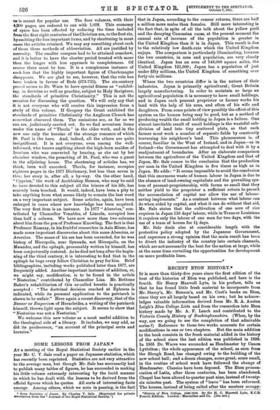SOME LESSONS FROM JAPAN.*
AT a meeting of the Royal Statistical Society earlier in the year Mr. C. V. Sale read a paper on Japanese statistics, which has recently been reprinted. Statistics are not very attractive to the average man, but though Mr. Sale has necessarily had to publish many tables of figures, he has succeeded in making his little volume extremely interesting by the lucid manner in which he has dealt with the lessons to be derived from the official figures which he quotes. All sorts of interesting facts emerge. Among others, which we note in passing, is the fact • Some Statistics of Japan. By Charles V. Sale. (Reprinted for private mrculs.tion from the "Journal of the Royal Statistical Society.")
that in Japan, according to the census returns, there are half a million more males than females. Still more interesting is the fact that, in spite of all the talk about the yellow peril and the decaying Caucasian races, at the present moment the annual rate of increase of the population is greater in the United Kingdom than it is in Japan. This result is due to the relatively low death-rate which the United Kingdom enjoys. The comparison is particularly illuminating, because the two countries, in area and population, are very closely identical. Japan has an area of 148,000 square miles, the United Kingdom 121,000; Japan has a population of just under fifty millions, the United Kingdom of something over forty-six millions.
Where the two countries differ is in the nature of their industries. Japan is primarily agricultural ; Great Britain largely manufacturing. In order to maintain so large an agricultural population it is necessary to have small holdings, and in Japan each peasant proprietor or farmer works his land with the help of his sons, and often of his wife and daughters. From some points of view possibly the effect of this system on the human being may be good, but as a method of producing wealth the small holding in Japan is a failure. One almost inevitable result of small holdings is the wasteful sub- division of land into tiny scattered plots, so that each farmer must work a number of separate fields by constantly traversing his neighbour's land. This phenomenon is, of course, familiar in the West of Ireland, and in Japan—as in Ireland—the Government has attempted to deal with it by a readjustment of boundaries. After an elaborate comparison between the agriculture of the United Kingdom and that of Japan, Mr. Sale comes to the conclusion that the production per man in the United Kingdom is five times as high as in Japan. He adds : " It seems impossible to avoid the conclusion that this enormous waste of human labour in Japan is due to the absence of land-owning capitalists and the prevailing sys- tem of peasant-proprietorship, with farms so small that they neither yield to the proprietor a sufficient return to permit the accumulation of capital nor allow the use of labour- saving implements." As a contrast between what labour can do when aided by capital, and what it can do without that aid, Mr. Sale states that the cultivation of one acre of rice requires in Japan 110 days' labour, while in Texas or Louisiana it requires only the labour of one man for two days, with the use of a team of horses for 1 days.
Mr. Sale deals also at considerable length with the protective policy adopted by the Japanese Government, and expresses a strong opinion that the main result has been to divert the industry of the country into certain channels, which are not necessarily the best for the nation at large, while at the same time curtailing the opportunities for development on more profitable lines.






























































 Previous page
Previous page